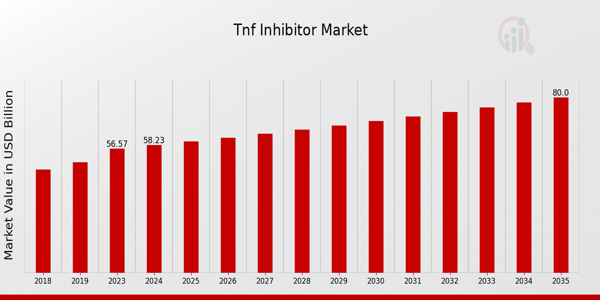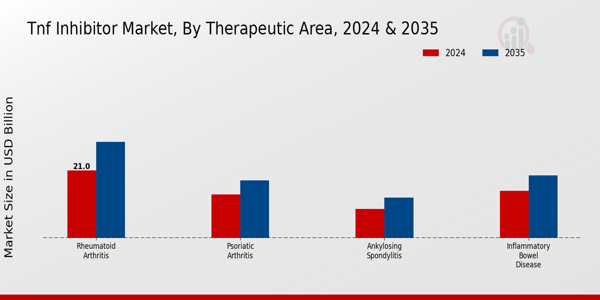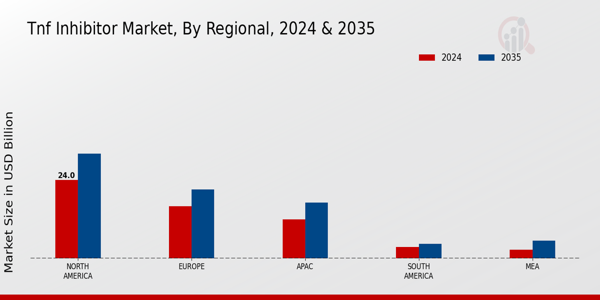Global TNF Inhibitor Market Overview
As per MRFR analysis, the TNF Inhibitor Market Size was estimated at 56.57 (USD Billion) in 2023. The TNF Inhibitor Market is expected to grow from 58.23(USD Billion) in 2024 to 80.0 (USD Billion) by 2035. The TNF Inhibitor Market CAGR (growth rate) is expected to be around 2.93% during the forecast period (2025 - 2035).
Key TNF Inhibitor Market Trends Highlighted
The TNF Inhibitor Market is experiencing notable growth driven by several key factors. The increasing prevalence of autoimmune diseases, such as rheumatoid arthritis and Crohn's disease, is fueling demand for effective treatment options. As awareness of these conditions rises, more patients seek medical intervention, prompting healthcare providers to prescribe TNF inhibitors. Additionally, advancements in drug development, including the introduction of biosimilars, are expanding the availability of these therapies and making them more accessible to a broader patient population. The shift towards personalized medicine is also influencing the market, as healthcare professionals tailor treatments based on individual patient needs.
Opportunities abound in the TNF Inhibitor Market, particularly in emerging economies where the healthcare infrastructure is evolving. These regions present a chance for pharmaceutical companies to introduce their products and cater to a growing patient base. The growing adoption of telemedicine and digital health technologies may enhance patient monitoring and adherence to treatments, further driving the demand for TNF inhibitors. Additionally, increasing investment in research and development offers the possibility of discovering new therapies that could target TNF more effectively, creating additional avenues for growth. In recent times, trends in the TNF Inhibitor Market indicate a rising focus on combination therapies, where TNF inhibitors are used alongside other medications to enhance treatment efficacy.
The regulatory landscape is also changing, with agencies working to streamline the approval process for new drugs. This evolution may lead to quicker access for patients in need of urgent treatment. Furthermore, patient-centric approaches, emphasizing healthcare provider-patient relationships and enhancing overall treatment experiences, are gaining traction. These trends highlight a dynamic market landscape with various factors influencing its development.

Source: Primary Research, Secondary Research, MRFR Database and Analyst Review
TNF Inhibitor Market Drivers
Increasing Prevalence of Autoimmune Diseases
One of the primary drivers fueling growth in the TNF Inhibitor Market is the increasing prevalence of autoimmune diseases such as rheumatoid arthritis, Crohn's disease and psoriasis. As these conditions become more common worldwide, there is a heightened demand for effective treatments, driving the need for TNF inhibitors. The expanding population, aging demographics, and lifestyle changes contribute to a rise in autoimmune disorders, creating a substantial market for pharmaceutical companies.
Additionally, increased awareness and diagnosis of autoimmune diseases, combined with advancements in biotechnology, support the growth of this market segment. Patients and healthcare providers are increasingly looking for targeted therapies that can provide relief and improve quality of life. As the market grows, research and development efforts are likely to intensify, leading to the introduction of new TNF inhibitors that cater to specific needs, further enhancing the TNF Inhibitor Market landscape.
The anticipated success will likely be maintained over the next few years alongside improvements in drug formulations and delivery systems that maximally enhance patient compliance and therapeutic results. In addition, ongoing clinical trials and studies will deepen the understanding of the safety and efficacy of current and novel TNF inhibitors, thus strengthening their place in the treatment of autoimmune diseases.
Technological Advancements in Drug Development
Innovations in biotechnology and pharmaceutical research are pivotal in driving the TNF Inhibitor Market . With continuous investment in drug development technology, there is an increase in the production of more effective and targeted TNF inhibitors. These advancements lead to improved therapeutic profiles, fewer side effects and enhanced patient outcomes. The implementation of novel drug delivery systems, including biologics and biosimilars, allows for more personalized treatment plans tailored to individual patient needs.
This further enhances the growth prospects for the industry as healthcare professionals seek out cutting-edge solutions for complex medical conditions.
Growing Geriatric Population
The rising geriatric population globally is a significant driver of the TNF Inhibitor Market . As older adults are more susceptible to various autoimmune diseases and inflammatory disorders, there is a higher demand for effective TNF inhibitor treatments. This demographic trend emphasizes the need for innovative therapies specifically designed to address the unique health challenges faced by aging individuals. Consequently, pharmaceutical companies are focusing on research and development efforts aimed at creating tailored therapies that improve the quality of life for older patients, fueling market growth.
TNF Inhibitor Market Segment Insights
TNF Inhibitor Market Therapeutic Area Insights
The TNF Inhibitor Market in the Therapeutic Area segment is showing considerable promise, with robust market revenues projected for the coming years. By 2024, the market is valued at 58.23 USD Billion and is expected to grow to 80.0 USD Billion by 2035. This growth trajectory is primarily driven by the rising prevalence of autoimmune diseases, where TNF inhibitors play a vital role in managing symptoms and improving the quality of life for patients. Within this segment, Rheumatoid Arthritis stands out as a significant contributor, with a market valuation of 21.0 USD Billion in 2024 and an anticipated rise to 30.0 USD Billion by 2035, highlighting its majority holding in the overall landscape. This condition affects millions globally, leading to a higher demand for effective treatment options.
Psoriatic Arthritis holds a relevant position within the TNF Inhibitor Market, with a valuation of 13.5 USD Billion in 2024 and expected to reach 18.0 USD Billion by 2035. The increasing awareness about the disorder and the development of advanced therapeutic options are factors fueling market growth in this sub-segment. Moreover, Ankylosing Spondylitis, valued at 9.0 USD Billion in 2024, which may grow to 12.5 USD Billion by 2035, although representing a smaller market share compared to Rheumatoid Arthritis, showcases the ongoing need for innovative therapies aimed at addressing chronic and debilitating symptoms associated with this condition.
On the other hand, Inflammatory Bowel Disease, with a valuation of 14.73 USD Billion in 2024 and increasing to 19.5 USD Billion by 2035, is also a significant area in terms of the TNF Inhibitor Market revenue. This segment reflects the urgent requirements for effective management solutions in conditions like Crohn's disease and ulcerative colitis that drastically affect patients’ lives. The existential burden of these conditions contributes to the growing demand for TNF inhibitors, utilizing their anti-inflammatory properties to provide relief. The market statistics reveal lucrative opportunities, driven by advancements in drug development and the introduction of biologics, bolstering the landscape of the TNF Inhibitor Market . Overall, the segment's growth potential is reinforced by healthcare providers emphasizing early diagnosis and intervention, which are critical to enhancing patient outcomes and managing these chronic conditions effectively.

Source: Primary Research, Secondary Research, MRFR Database and Analyst Review
TNF Inhibitor Market Administration Route Insights
The Administration Route segment within the TNF Inhibitor Market is projected to play a crucial role in the market's overall dynamics. Key administration routes include Injectable, Oral and Intravenous. The Injectable route often dominates due to the widespread effectiveness and rapid action it enables, particularly in acute settings. Oral formulations, while gaining traction for their convenience and patient compliance, are less prevalent compared to Injectables.
The Intravenous route, though less common than its counterparts, is significant in hospital settings for delivering faster relief to patients with severe conditions. Market trends indicate a growing adoption of all administration methods, driven by the rising incidence of autoimmune diseases and favorable regulatory scenarios. However, challenges such as high costs and potential adverse effects could impact future growth. Overall, the TNF Inhibitor Market data illustrates a steady inclination towards diverse administration routes, reflecting evolving patient preferences and therapeutic requirements.
TNF Inhibitor Market Drug Type Insights
The TNF Inhibitor Market is poised for substantial growth within the Drug Type segment, which encompasses various therapeutic agents such as Monoclonal Antibodies, Fusion Proteins and Recombinant Proteins. Monoclonal Antibodies have emerged as a leading treatment option due to their specificity and effectiveness, significantly impacting chronic inflammatory conditions. Fusion Proteins, although less prevalent, hold substantial promise in enhancing therapeutic outcomes by combining beneficial characteristics from different proteins.
Meanwhile, Recombinant Proteins play a vital role in targeted therapies, contributing at a steady growth pace. Collectively, these drug types present diverse opportunities for pharmaceutical advancements and cater to an increasing patient population seeking effective treatments. Overall, market growth is driven by rising incidences of autoimmune diseases, increasing healthcare expenditures, and ongoing research in protein engineering, further enhancing the TNF Inhibitor Market statistics. As the industry evolves, the segmentation of the TNF Inhibitor Market will continue to adapt, providing a clearer picture of growth trajectories and competitive dynamics within the sector.
TNF Inhibitor Market End User Insights
The TNF Inhibitor Market reflects significant growth in the End User segment, which includes Hospitals, Specialty Clinics and Homecare Settings. Hospitals are essential for administering intensive TNF inhibitor treatments, leveraging their advanced medical resources and expertise, thus playing a pivotal role in this market. Specialty Clinics are experiencing a rise in demand as they cater specifically to patients requiring targeted therapies, offering tailored treatment plans that enhance patient outcomes.
Meanwhile, Homecare Settings are gaining traction due to the increasing shift towards at-home treatment options, providing convenience and accessibility to patients, which is particularly important for ongoing TNF inhibitor therapy. The TNF Inhibitor Market segmentation highlights these areas as crucial components that contribute to the overall dynamics of the industry. As patient preferences evolve and healthcare systems adapt, opportunities abound for each of these End User categories, driving ongoing innovation and expansion within the TNF Inhibitor Market .
The overall market is anticipated to maintain steady growth fueled by these emerging trends and the continuing need for effective management of autoimmune diseases.
TNF Inhibitor Market Regional Insights
The TNF Inhibitor Market is projected to see substantial growth across its regional segments, with North America leading the market, valued at 24.0 USD Billion in 2024 and expected to reach 32.0 USD Billion by 2035, indicating its dominant role in the industry due to advanced healthcare infrastructure and a high prevalence of autoimmune diseases. Europe follows, with a market value of 16.0 USD Billion in 2024, rising to 21.0 USD Billion in 2035, driven by increasing demand for innovative therapies. The APAC region, valued at 12.0 USD Billion in 2024 and growing to 17.0 USD Billion by 2035, shows significant potential, primarily due to rising patient awareness and healthcare spending.
South America represents a smaller segment, currently at 3.5 USD Billion in 2024, but projects growth to 4.5 USD Billion by 2035, driven by improving healthcare access. The MEA region, with a valuation of 2.73 USD Billion in 2024, is anticipated to reach 5.5 USD Billion by 2035, reflecting emerging market opportunities. Overall, the TNF Inhibitor Market revenue is shaped significantly by these dynamics in the respective regions, demonstrating a comprehensive segmentation that highlights both opportunities and challenges across different geographical landscapes.

Source: Primary Research, Secondary Research, MRFR Database and Analyst Review
TNF Inhibitor Market Key Players and Competitive Insights
The TNF Inhibitor Market has seen considerable growth and transformation over the years, driven by the increasing prevalence of autoimmune disorders and inflammatory diseases. The competition within this market is characterized by a diverse range of key players, each striving to capture market share through innovative drug development, strategic collaborations, and robust marketing strategies. The landscape is influenced by factors such as regulatory approvals, patent expirations, and the emergence of biosimilars, which continue to reshape the competitive dynamics. Companies in this space are focusing on enhancing therapeutic efficacy and improving patient outcomes while also navigating the challenges posed by pricing pressures and market access hurdles. This market remains highly competitive, with players constantly seeking to leverage their strengths and capitalize on emerging opportunities across various geographic regions.
Roche stands out in the TNF Inhibitor Market as a formidable entity, with a notable presence characterized by its extensive research and development capabilities. The company is recognized for its commitment to innovation, continuously working on novel therapeutics and improving existing formulations. Roche’s robust portfolio includes products that have made a significant impact in treating conditions such as rheumatoid arthritis and inflammatory bowel disease. The company benefits from a strong operational framework and has established itself as a leader through its strategic partnerships and collaborations. Moreover, Roche’s focus on personalized medicine and its deep understanding of patient needs position the company favorably in the face of emerging competition and market trends.
Regeneron Pharmaceuticals has also made significant inroads in the TNF Inhibitor Market, leveraging its strengths in biopharmaceutical research and development. With a strong pipeline of innovative therapies, Regeneron is actively advancing its offerings in the realm of autoimmune diseases, aiming to address unmet medical needs. The company’s strategic focus on precision medicine and its commitment to research has allowed it to create a solid foothold in the market. Regeneron is recognized for its unique approach to drug development, which incorporates advanced technologies such as its proprietary VelociSuite platform. This technological edge, combined with a clear understanding of market demands, enables Regeneron to maintain a competitive advantage as it continues to expand its presence in the rapidly evolving landscape of TNF inhibitors.
Key Companies in the TNF Inhibitor Market Include
- Regeneron Pharmaceuticals
TNF Inhibitor Market Developments
Recent developments in the TNF Inhibitor Market have been marked by significant advancements and collaborations among major companies. Roche and Regeneron Pharmaceuticals are focusing on enhancing their product offerings by investing in research and development for new formulations, which aim to address unmet medical needs. Amgen, Johnson & Johnson, and Merck are also actively engaged in clinical trials to expand the applications of their existing therapies.
Meanwhile, companies like Pfizer and Eli Lilly are witnessing growth in market valuation as their new drugs receive favorable regulatory reviews and market access. Bristol Myers Squibb and AbbVie are emphasizing strategic partnerships to optimize their portfolios, while Gilead Sciences and Takeda Pharmaceutical are exploring innovative approaches to boost their presence in the TNF inhibitor space. Recent mergers and acquisitions, particularly in aligning resources for enhanced R&D capabilities, have been a focal point, with several firms aiming to consolidate their positions. Novartis and AstraZeneca continue to engage in expansion strategies to leverage new therapeutic areas while the overall competition remains intense, driving innovation and increasing investment in the TNF inhibitor landscape.
TNF Inhibitor Market Segmentation Insights
TNF Inhibitor Market Therapeutic Area Outlook
- Inflammatory Bowel Disease
TNF Inhibitor Market Administration Route Outlook
TNF Inhibitor Market Drug Type Outlook
TNF Inhibitor Market End User Outlook
| Attribute/Metric Source: |
Details |
| MARKET SIZE 2023 |
56.57(USD Billion) |
| MARKET SIZE 2024 |
58.23(USD Billion) |
| MARKET SIZE 2035 |
80.0(USD Billion) |
| COMPOUND ANNUAL GROWTH RATE (CAGR) |
2.93% (2025 - 2035) |
| REPORT COVERAGE |
Revenue Forecast, Competitive Landscape, Growth Factors, and Trends |
| BASE YEAR |
2024 |
| MARKET FORECAST PERIOD |
2025 - 2035 |
| HISTORICAL DATA |
2019 - 2024 |
| MARKET FORECAST UNITS |
USD Billion |
| KEY COMPANIES PROFILED |
Roche, Regeneron Pharmaceuticals, Amgen, Johnson and Johnson, Merck, Pfizer, Eli Lilly, Bristol Myers Squibb, AbbVie, Sanofi, Takeda Pharmaceutical, Novartis, AstraZeneca, Gilead Sciences |
| SEGMENTS COVERED |
Therapeutic Area, Administration Route, Drug Type, End User, Regional |
| KEY MARKET OPPORTUNITIES |
Biologics for autoimmune diseases, Biosimilars gaining traction, Expanding indications for TNF inhibitors, Increased focus on personalized medicine, Rising prevalence of chronic inflammatory conditions |
| KEY MARKET DYNAMICS |
Increasing prevalence of autoimmune diseases, Growing elderly population, Rising demand for advanced therapies, Expanding pipeline of novel drugs, Competitive pricing and reimbursement pressures |
| COUNTRIES COVERED |
North America, Europe, APAC, South America, MEA |
Frequently Asked Questions (FAQ) :
The Global TNF Inhibitor Market is expected to be valued at 58.23 USD Billion in 2024.
By 2035, the Global TNF Inhibitor Market is projected to reach a value of 80.0 USD Billion.
The expected CAGR for the Global TNF Inhibitor Market from 2025 to 2035 is 2.93%.
North America is anticipated to hold the largest market share with a value of 24.0 USD Billion in 2024.
The market value for TNF inhibitors in Rheumatoid Arthritis is expected to be 30.0 USD Billion by 2035.
The market value for Psoriatic Arthritis in 2024 is expected to be 13.5 USD Billion.
Major players in the Global TNF Inhibitor Market include Roche, Amgen, Johnson and Johnson, Pfizer, and AbbVie.
The expected market size for Inflammatory Bowel Disease is projected to be 19.5 USD Billion in 2035.
The projected market size for South America in the Global TNF Inhibitor Market is expected to be 4.5 USD Billion by 2035.
The market size for Ankylosing Spondylitis is expected to be 9.0 USD Billion in 2024.

















